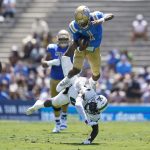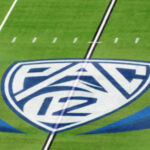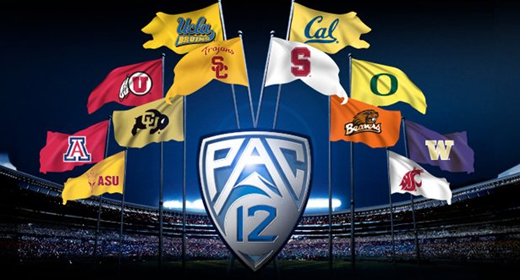Last year was not great for the Pac-12. But with Kayvon Thibodeaux, Drake London and Devin Lloyd, the conference did have some players with national star power. Outside of USC quarterback Caleb Williams, who are some names who might surprise this fall? — @boscpenn83
The lack of star power has been a significant issue for the conference, along with the dearth of playoff bids.
The Pac-12 hasn’t produced a Heisman Trophy finalist since Stanford’s Bryce Love made the cut for New York City in 2017, and it has been off the voting radar since Washington State’s Gardner Minshew made the top-10 in 2018.
Heisman top-10 finishers by conference from 2018-21:
SEC: 13
Big Ten: 10
Big 12: six
ACC: five
Group of Five: four
Pac-12: one (Minshew)
Williams enters the 2022 season as the No. 1 star in the conference by a significant margin. He has built-in name recognition nationally from his exploits at Oklahoma. Next season, he will play the glamor position at the glamor school — same as previous Pac-12 winners Carson Palmer and Matt Leinart.
The best player in the conference in ’22 could very well be Oregon linebacker Noah Sewell, but it’s difficult for defenders to generate coast-to-coast attention unless they project as a No. 1 draft pick (as Thibodeaux did).
(Other elite defensive players with limited opportunity to gain traction include Washington’s Zion Tupuola-Fetui, UCLA’s Mitchell Agude and Utah’s Clark Phillips III.)
Typically, star power comes from the skill positions. The top returning candidates for high-level production and attention would be Utah quarterback Cam Rising and tailback Tavion Thomas, ASU quarterback Jayden Daniels and UCLA quarterback Dorian Thompson-Robinson and tailback Zach Charbonnet.
Two quarterback arrivals from other leagues — Oregon’s Bo Nix (from Auburn) and Washington’s Michael Penix (from Indiana) — bring name recognition but must play at a higher level.
Put another way: No Pac-12 offensive players are currently projected for the first round of the 2023 draft. That state of play will impact the off-season media attention which, in turn, sets the framework for in-season media attention.
Because of the lack of national exposure that results from both the late kickoffs and the Pac-12 Networks’ limited reach, players in the small media markets throughout the conference footprint face an enormous climb to national relevance.
Even ‘Minshew Mania’ couldn’t get the WSU quarterback to New York.
(The exception to the small market reality is Oregon, which has produced the Pac-12’s only Heisman winner in the past 50 years who didn’t play for USC: quarterback Marcus Mariota in 2014.
(If Nix has a big season, he will undoubtedly get coast-to-coast attention.)
For those reasons and others, the Williams addition was massive for the Pac-12: One of the nation’s best-known players joined a blue blood program in the No. 2 media market.
He’s six months from taking his first snap for the Trojans. But in some ways, it’s already his league.
How close is the Pac-12 to making the College Football Playoff? How many years away? What grade would you give Pac-12 commissioner George Kliavkoff? And what’s the latest on TV rights. — @Kevin10TV
A spate of questions here; let’s go in reverse order:
— There is nothing new on the TV rights. Negotiations will begin sometime next winter and should last several months. Until then, keep an eye on the Big Ten, which is expected to announce its next cycle of media deal this spring.
— We recently gave Kliavkoff high marks for managing the issues within his control but added: “Had we known back on July 1 the course that events would take, the Hotline would have declared Kliavkoff’s first six months a success while quoting famed Caddyshack prognosticator Carl Spackler: ‘I don’t think the heavy stuff’s gonna come down for quite a while.’”
— The Pac-12 could be 10 months away from making the playoff if USC, Oregon or Utah produces a 13-0 or 12-1 season, but that seems unlikely with the returning personnel and schedules. (No other team looks remotely capable.)
Were the Hotline to wager on the identity and timing of the conference’s next playoff participant, it would be USC in the 2024 season.
The Trojans have restocked their skill positions via the transfer portal but are flawed on the offensive line and throughout the defense. It could take Lincoln Riley multiple recruiting cycles to build the depth chart needed for a 13-0/12-1 season.
That said, we wouldn’t be flabbergasted if the Trojans qualified in ’23, or if Oregon or Utah made the cut in either of the next two years.
By the way, the framework for next season will be established on the first weekend of play. The Utes open at Florida, while the Ducks face Georgia in Atlanta.
When will Friday night football games be finalized? — @purpledawg96
We should know by early June, when the Pac-12 releases the kickoff times for the non-conference games and the so-called “special date” matchups.
The master schedule unveiled in December featured just one Friday conference game that wasn’t on Thanksgiving weekend (Colorado at USC in the middle of November).
A few more could be added this spring.
What is your take on why UCLA coach Chip Kelly is taking so long to hire a defensive coordinator? Who would be some excellent candidates in your view? — @BruinSharman
First, we should note that UCLA’s website still lists Jerry Azzinaro as the defensive coordinator; there has been no official notification from the school of a change in leadership.
That said, multiple media outlets reported Azzinaro’s resignation weeks ago.
What’s taking so long? The Bruins missed the window to announce a new coordinator before National Signing Day, so the only deadline at this point is spring practice.
The best candidate, former Vanderbilt head coach Derek Mason, was hired by Oklahoma State.
Honestly, we don’t know where Chip Kelly will turn. But it’s reasonable to expect him to focus on candidates with experience coaching against the style of offense deployed by USC’s Lincoln Riley.
Best case scenario for the athletic department at my sad excuse of an alma mater, Arizona State? — @justnbaird
There’s a five-step process for recovery, at least on the football side:
1. The NCAA sends its Notice of Allegations (the official issuance of charges) this spring.
2. The allegations do not include any Level I violations.
3. The NCAA doesn’t accuse coach Herm Edwards of direct involvement in improper meetings or conduct.
4. ASU isn’t at risk of a postseason ban.
5. The page is turned and the Sun Devils are able to restart high-level recruiting for the 2022-23 cycle.
Speed is of the essence. The longer it takes for the resolution process to unfold, the more harm the investigation does to ASU and the more benefit it provides division rivals, especially Arizona.
ESPN’s Joe Lunardi, as of Feb. 8, projects better seeds for Arizona (1), UCLA (2) and USC (6) than you do. Doesn’t your relativity poor perception of the Pac 12 contribute to the league’s struggles to achieve the best seeds and the most number of seeds for its league members? — @UA_Cattracks
First, you have picked one set of projections (Lunardi) out of many. Plenty of them have Arizona as a No. 2 seed — some even peg the Wildcats for a No. 3 and UCLA for a No. 5.
Second, my projections don’t have a shred of impact whatsoever.
The problem for the Pac-12 is the collective’s performance in non-conference games. The winning percentage of .664 is far lower than that of the Big 12, Big Ten, Big East and SEC, and also behind the ACC and Mountain West.
In the era of the 68-team field, there have been three occasions in which the Pac-12 produced a non-conference winning percentage in the 60s. Not once did it send four teams to the NCAAs:
2011: 61.1 percent/two bids
2017: 69.8 percent/three bids
2018: 61.3 percent/three bids
2022: 66.4 percent/??? bids
My current projections include Oregon in the field as the fourth team. So I’m actually more optimistic than the analytics suggest I should be.
On a scale of 1-10, how likely is it that Stanford will have a new athletic director by the fall of 2022? — @OrangeMarkD
Bernard Muir’s decade-long run at the top of Stanford athletics hasn’t been entirely smooth, especially with regard to the basketball program and the ‘Operation Varsity Blues’ scandal.
Our belief is that he would strongly consider similar posts on the East Coast — he’s from Florida and attended college in New England — but that would require a desirable job opportunity.
We don’t know the specifics of Muir’s employment status, because Stanford isn’t bound to release contracts. Could the Cardinal proactively make a change? It’s possible but, in our view, unlikely.
To answer your question: 2 or 3.
What are the odds that Cal moves on from Mark Fox, and who replaces him if they do? — @cgboan
At least 50-50 given the current state of the program (moribund) and its future prospects (gloomy).
We view the calculation in this manner: Do the economic and competitive costs of bringing Fox back for the 2022-23 season outweigh the immediate financial hit that would come with making a change next month?
Cal’s woeful existence isn’t entirely on Fox, who doesn’t have a dedicated practice facility and, like football coach Justin Wilcox, possesses limited options in the transfer portal compared to many Pac-12 peers (because of the academic standards).
But it’s difficult to envision the Bears’ trajectory changing under his watch. The longer the stagnation, the more costly the repair work.
Support the Hotline: Receive three months of unlimited access for just 99 cents. Yep, that’s 99 cents for 90 days, with the option to cancel anytime. Details are here, and thanks for your support.
*** Send suggestions, comments and tips (confidentiality guaranteed) to pac12hotline@bayareanewsgroup.com or call 408-920-5716
*** Follow me on Twitter: @WilnerHotline
*** Pac-12 Hotline is not endorsed or sponsored by the Pac-12 Conference, and the views expressed herein do not necessarily reflect the views of the Conference.
Related posts:

(AP Photo/Ashley Landis)
Pac-12 survival: UC regents prepare to discuss impact report on UCLA’s move to the Big Ten
(AP Photo/Ralph Freso, File)
Wilner Hotline – Former Big 12 boss doesn’t expect mass Pac-12 exodus, says conference should consider San Diego State Pac-12 need-to-knows: Trap games and Power Five foes highlight Week Two lineup
Pac-12 need-to-knows: Trap games and Power Five foes highlight Week Two lineup
 Pac-12 football fan poll: Which of the four teams ranked in the AP top 15 is an imposter?
Pac-12 football fan poll: Which of the four teams ranked in the AP top 15 is an imposter?
